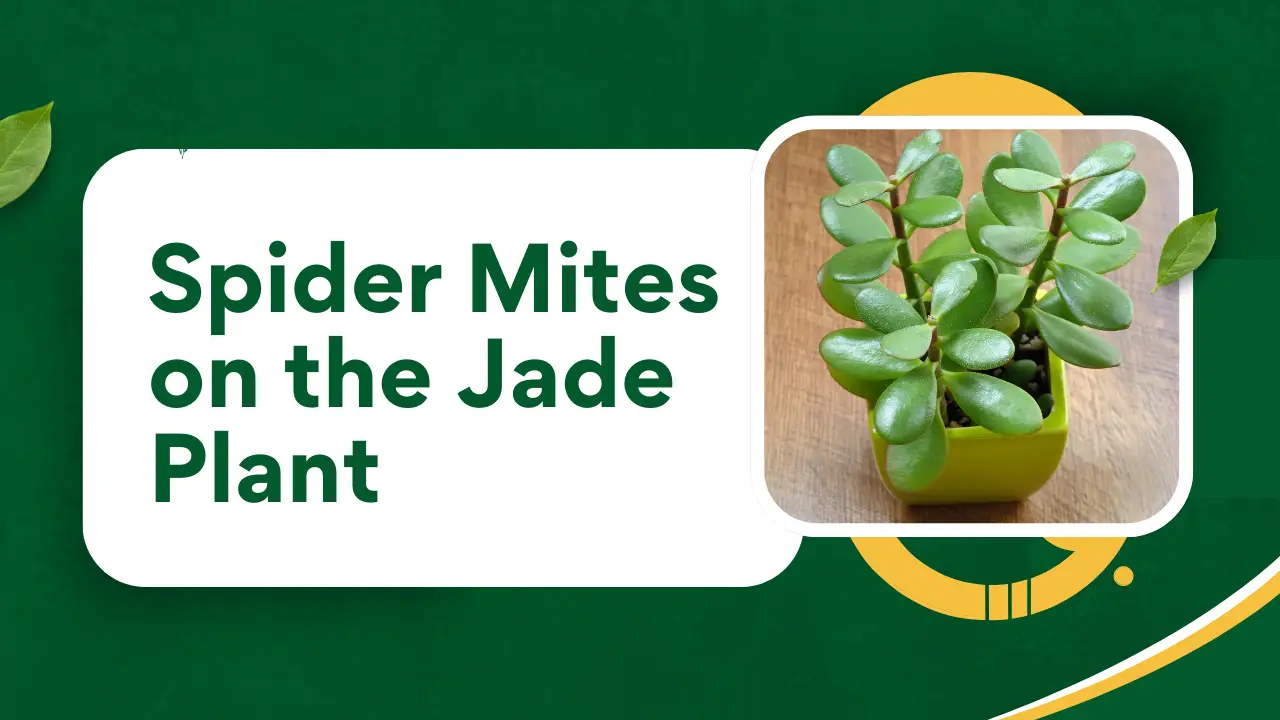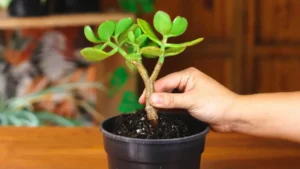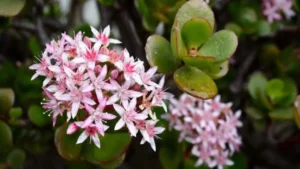In this article, we will discuss the creepy crawly creature that is unwelcome on jade plants.
It’s often assumed that spider mites are insects, but they are actually eight-legged arachnids closely related to spiders and ticks.
1/60 to 1/25 inches in size, these spider mites damage your jade plants by spinning silky webbing on foliage.
In the category of spider mites, there are hundreds of different species that attack both indoor and outdoor plants. Additionally, they are available in many colors. These include red, yellow, green, and brown. There are even some that change color throughout the year, while others are translucent.
It is most common for spider mites to cluster on the undersides of leaves, sucking on tissues and causing damage. However, we will discuss all the ways to get rid of spider mites on jade here. Also, read to the end to discover what the ultimate solution is in case all else fails.
Table of Contents
What are the Causes of Spider Mites?
Heat and dry weather are ideal conditions for spider mites. For them, about 80 degrees is ideal. And they are most prevalent from July to September when the weather is most conducive.
Yet, there is one notable exception: the spruce spider mite ( Oligonychus ununguis ), which is most active in the spring and fall. It causes yellowing of needles and gradual defoliation of pine trees that can cause their death. Thus, the spruce spider mite is a serious pest of pine trees.
In winter, indoor plants are most susceptible to mite infestations, so be sure to check them regularly as the indoor air becomes drier.
Signs of Spider Mites’ Damages
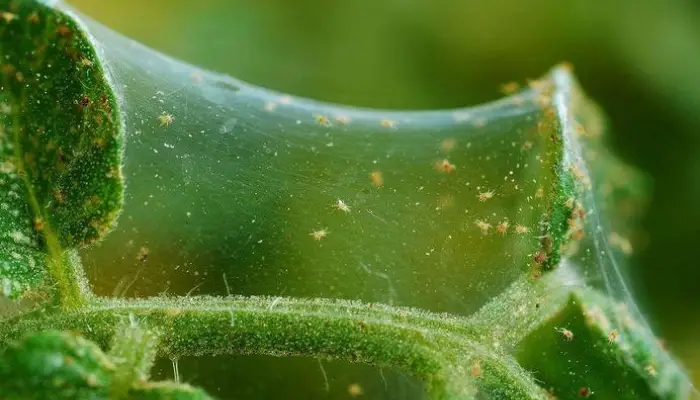
By sucking plant juice from the leaves, spider mites often leave the leaves dry, yellow, and stippled, or with pale yellow spots or blotches.
In conifers, spider mites cause yellowing and eventually fall off older, inner needles. There is also a possibility that spider mites can suck chlorophyll from leaves, causing small white dots to appear.
Also, there are certain spider mites that inject toxins into the leaves, which discolor and distort them. Seeing any of these symptoms, especially if they are accompanied by fine white webbing on the leaves, indicates spider mite infestation.
The mites are small enough that you will not usually be able to see them with the naked eye. However, you can see them with a magnifying glass if you hold the white paper under the affected leaf and tap it with a pencil or your finger.
Plants most susceptible to this disease include cucurbits (squash, pumpkins, cucumbers, etc.), beans, tomatoes, and many other types of landscape trees and shrubs. Spider mites can affect many types of indoor houseplants. Those with thin, tender leaves are most susceptible. When the weather is warm and dry, spider mites are most likely to damage your plant.
Spider Mites on Jade Plants: How to Spot Them
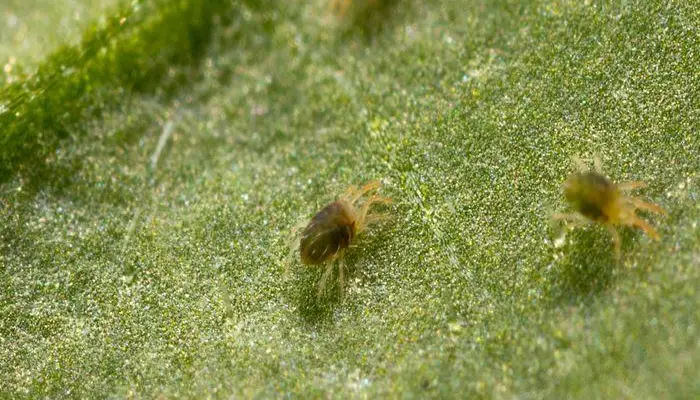
When humidity drops, jade plants are more likely to have spider mites. You may already know that this plant does not require regular watering. And spider mites love lower humidity levels, so your jade plant is an ideal habitat for them.
Keep an eye on where the leaf attaches to the stem every now and then. In addition, spider mites on jade plant skin may create tiny holes that look like pores on the underside of leaves. As a result, they absorb the plant juices and cause the jade plant to discolor.
Beware of Pink Jade Plants
It might be more difficult to inspect some leaves if you prune your jade plant. Therefore, you should keep an eye on the leaf tips. When spider mites feed on your jade plant, the plant may blush and turn pink.
As spider mites use webs to move on plants, they cause the plants to feel sticky. It may not be possible to see the tiny webs. However, they give leaves an unpleasant gloopy texture.
The moment you observe either of the above signs, remove the plant from the group. In order to control this pest, quarantine should be your first line of defense.
How to Get Rid of Spider Mites on Jade Plant
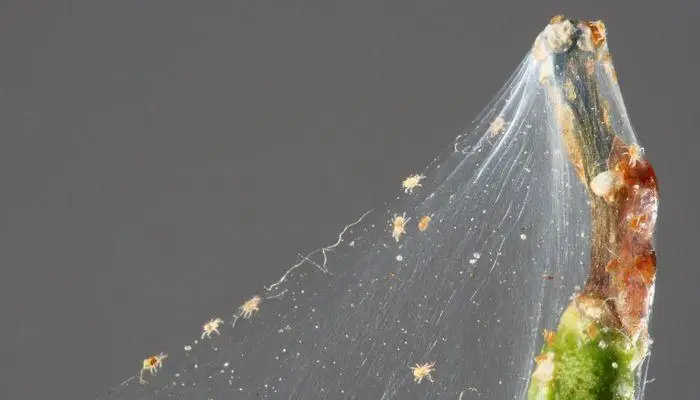
A jade plant with yellowing, dry leaves, and a look of illness may indicate a spider mite infestation. Yet, the good news is that there are several ways to get rid of spider mites.
1. Spray With Water
Very effective control of mites is to regularly spray plants with hard blasts of water, especially on the undersides of leaves and needles. Using this treatment regularly will prevent the mites from regaining a foothold on the plants. Plants in a kitchen sink or bathtub can be sprayed with water from a faucet sprayer.
2. Use Insecticidal Soaps or Oils
Spider mites are often cured by insecticidal soaps formulated to kill insects and other pests. Also, it is necessary to repeat the treatment frequently until the mite problem is resolved.
Plant oils, such as citrus, that are highly refined, are also highly effective against mites since they smother them. Additionally, horticultural oil is less likely to kill beneficial insects than chemical pesticides.
3. Encourage Predators
Several predatory insects and mites feed on spider mites. There are several predatory mites that are available at larger garden centers and online retailers for treating plants. Examples include Phytoseiulus persimilis, Amblyseius californicus, and Amblyseius andersoni. Among the helpful insects are big-eyed bugs (Geocoris spp. ), ladybugs, lacewings (Chrysopa spp. ), predatory thrips, and spined soldiers.
It may be possible to control spider mite infestations outdoors without hands-on treatment since spider mites have a large number of natural predators.
4. Use Neem Oil
Although neem oil is safe for humans and most animals, it kills insects, pests, and mites. This oil contains azadirachtin, which interferes with insects and mites’ feeding, molting, mating, and egg-laying cycles.
5. Use Pyrethroid Pesticide
A pyrethroid pesticide is a mixture of natural pyrethrins and chemicals designed to enhance its performance. In pure form, pyrethrin is a natural derivative of chrysanthemum flowers and is considered a safer pesticide.
In spite of the fact that pyrethroid pesticides contain added chemicals, they are still a safer alternative to other purely synthetic chemical pesticides. In most cases, pyrethroid pesticides are recommended against spruce spider mites.
6. Spray With Chemical Pesticide
A variety of commercial chemical pesticides can kill spider mite infestations, including malathion, bifenthrin, cyfluthrin, and kelthane. They should be reserved for very serious infestations of important plants, and only when all other methods have failed.
Use chemical pesticides with caution, especially on vegetables and fruits, as they are toxic to pets and humans. Be sure to read and follow the instructions on the label.
Also, it’s best to rotate between chemicals if you find you need to treat spider mites repeatedly. As they quickly develop a tolerance for chemical pesticides.
7. Call an Arborist or Tree Disease Specialist
In almost all cases, homeowners cannot treat spruce or other evergreen trees attacked by the spruce spider mite on their own. Only licensed professionals may have access to stronger pesticides than homeowners. It is recommended to use chemicals of this strength only when less toxic methods fail and an important tree is at risk.
Preventive Measures
There are some extra steps you need to take if you find this pest nemesis returning:
- As spider mites hatch continuously, you need to keep treating your plants for at least a month. Using isopropyl alcohol, spray the leaves frequently with commercial miticides.
- Don’t let the wind damage your succulents. It is a spider mite’s favorite pastime to surf the wind.
- As these pests build resistance to pesticides, rotate different spider mite control products every week.
- Use insecticidal soap, horticultural oils, and other products as well. Also, before switching from one chemical product to another, wait for 30 days. Meanwhile, use neem oil or isopropyl alcohol.
- Maintain a regular watering schedule and spray the leaves regularly. In addition to keeping them clean, be sure to remove spider mite eggs as well.
Conclusion
When viewed from a distance, spider mites are difficult to identify with the naked eye. Most of the time, these tiny ones pass into many gardens without anyone noticing. However, magnifying glasses can help you detect them. But no matter how few they are, each mite survives by sucking out the plant’s material.
Furthermore, they can ruin the aesthetic value of your beloved jade plant. When their numbers soar, they can kill your plants, especially annuals, if they form a full-blown infestation. However, in this article, I have listed several methods for getting rid of them as well as prevention measures.
But if all else fails, choose a systemic insecticide and apply it as a drench. It is the last resort against spider mites on jade plants.
Let me know if you have any questions regarding spider mites on jade in the comments section below.

